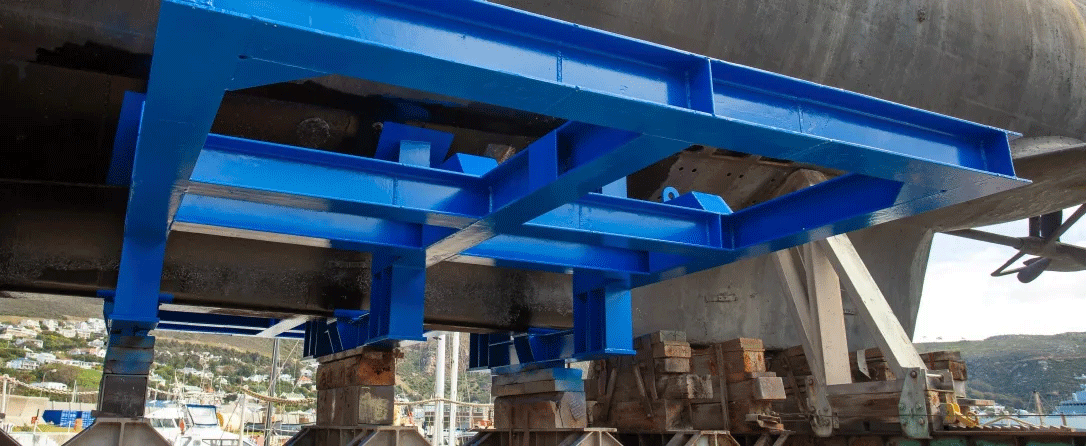Nearly eight years since it was closed to visitors, South Africa’s famous submarine museum is coming ashore thanks to two specially constructed cradles from shipbuilder Damen Shipyards Cape Town (DSCT).
The Assegaai Submarine Museum is the only preserved naval submarine on the continent. There are 124 preserved naval submarines in the world – only six are in the southern hemisphere and the Assegaai Submarine will be the first in Africa.
The two cradles, each 3.6m long x 9.1m wide, weigh 7 tonnes and were built using steel salvaged from old Damen ship transport cradles. DSCT has donated the cradles. On 14 August the cradles were officially handed over the Chief of the South African Navy Vice Admiral Monde Lobese. At the same ceremony Vice Admiral Lobese also handed over certificates of appreciation to the DSCT employees who worked on the cradle construction.
Speaking at the unveiling of the cradles and submarine in Cape Town Vice on Monday Admiral Lobese said: “Today we also celebrate the hard work, dedication, perseverance and never-give-up attitude of a handful of volunteers who absolutely refused to give up on their dream. That dream was to make sure that we as the South African Navy, can have the first – and only – submarine museum on the African continent. Once the Assegaai Museum is in place, she will be the 125th museum submarine in the world, but only the 7th in the Southern Hemisphere and the first one in Africa! This is indeed a noteworthy accomplishment.”
Work on the cradles started on November 2022. The submarine vessel will then be moved from the synchro lift where it is currently held to its display position and placed on the newly built foundations. The cradles will hold the submarine in place when it takes up its home next to the False Bay Yacht Club and NSRI Station 10 in Simon’s Town.
The museum was closed to the public in 2015 and will reopen once the Naval Heritage Trust has secured the necessary funding.
“Damen was approached by the Submarine Museum Team acting for the Naval Heritage Trust on behalf of the Naval Museum, as we have experience in this field and were willing to sponsor their part of the work required,” says Wafeeq Fakier, DSCT’s Project Manager for the construction of the cradles. “We were happy to help with the preservation of this historic naval vessel which will bring much joy to maritime enthusiasts once it opens its hatch to the public.”
To build the new cradles old Damen transport cradles were cut up to provide the components which were welded together into the new required design and form. The components were then transported to the ARMSCOR Naval Dockyard Simon’s Town to be assembled.
The static submarine museum will be managed and operated by the combined efforts of the Naval Heritage Trust, the local non-profit Facility Management Company (STADCO), and the South African Navy Museum. As in the past, guided tours will be conducted by volunteers and ex-submariners and the submarine will also be available for a variety of other activities such as company functions, school learning opportunities and even evening functions.
The Trust is currently in the process of trying to secure further sponsorship to ensure that the Submarine Museum can be realized in a reasonable time frame. Among the costs that need to be covered are R1.8m to move the submarine and R3m for the repair and restoration of the external hull of the vessel. Retired Rear Admiral (JG) Digby Thomson is one of several retired navy men who is assisting on the Naval Heritage Trust Submarine Museum Project. Thomson says: “We have raised about forty percent of the money we need to move the vessel. Once we have moved her, we will cut two holes forward and aft to allow for tour groups. We will use the funds from the visitors to finalize her look and make her more presentable to the public.”
The Assegai Submarine Museum is the last remaining of three French-built Daphné Class submarines operated by the South African Navy during the 70s, 80s and part of the 90s and successfully operated as a museum from 2008 to 2015 with the vessel lying alongside the outer wall of the Simon’s Town harbour. After 2015, the vessel required external maintenance and was kept on the synchro lift inside the harbour. The Museum has been closed ever since.
In the four and a half years it was open the submarine had received over 57 000 visitors from 110 countries.
“I personally believe that everybody should at least visit the inside of a submarine once in their lifetime, just for the experience, to have a look at the technology and to be able to say that they have been there and done it. It really is a fascinating world,” Thomson says.

